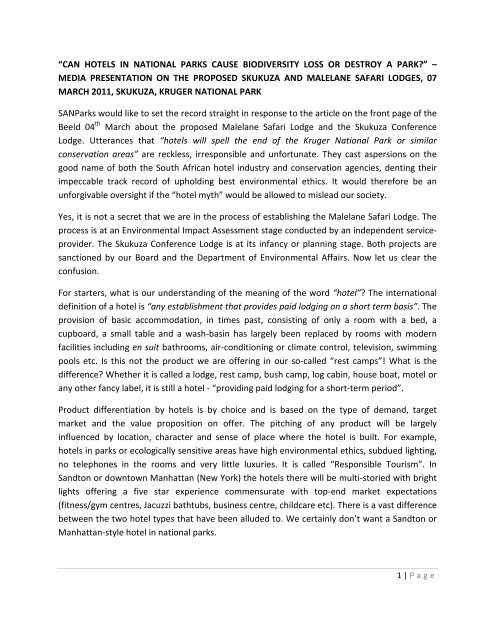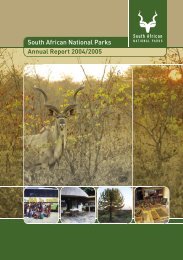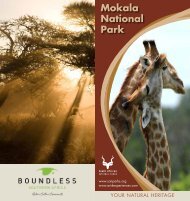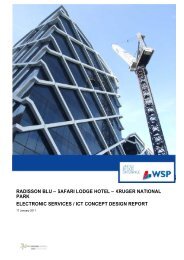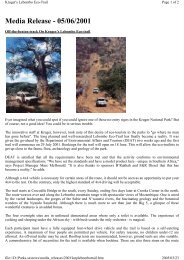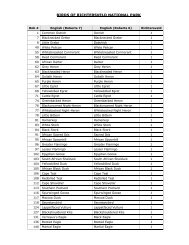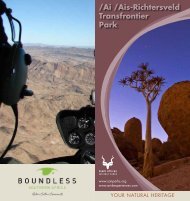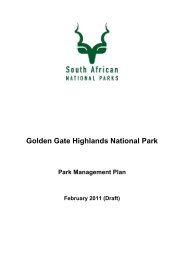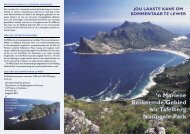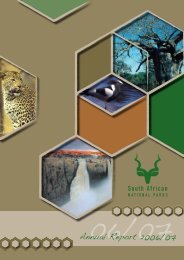can hotels in national parks cause biodiversity loss - SANParks
can hotels in national parks cause biodiversity loss - SANParks
can hotels in national parks cause biodiversity loss - SANParks
- No tags were found...
You also want an ePaper? Increase the reach of your titles
YUMPU automatically turns print PDFs into web optimized ePapers that Google loves.
“CAN HOTELS IN NATIONAL PARKS CAUSE BIODIVERSITY LOSS OR DESTROY A PARK?” –MEDIA PRESENTATION ON THE PROPOSED SKUKUZA AND MALELANE SAFARI LODGES, 07MARCH 2011, SKUKUZA, KRUGER NATIONAL PARK<strong>SANParks</strong> would like to set the record straight <strong>in</strong> response to the article on the front page of theBeeld 04 th March about the proposed Malelane Safari Lodge and the Skukuza ConferenceLodge. Utterances that “<strong>hotels</strong> will spell the end of the Kruger National Park or similarconservation areas” are reckless, irresponsible and unfortunate. They cast aspersions on thegood name of both the South Afri<strong>can</strong> hotel <strong>in</strong>dustry and conservation agencies, dent<strong>in</strong>g theirimpeccable track record of uphold<strong>in</strong>g best environmental ethics. It would therefore be anunforgivable oversight if the “hotel myth” would be allowed to mislead our society.Yes, it is not a secret that we are <strong>in</strong> the process of establish<strong>in</strong>g the Malelane Safari Lodge. Theprocess is at an Environmental Impact Assessment stage conducted by an <strong>in</strong>dependent serviceprovider.The Skukuza Conference Lodge is at its <strong>in</strong>fancy or plann<strong>in</strong>g stage. Both projects aresanctioned by our Board and the Department of Environmental Affairs. Now let us clear theconfusion.For starters, what is our understand<strong>in</strong>g of the mean<strong>in</strong>g of the word “hotel”? The <strong>in</strong>ter<strong>national</strong>def<strong>in</strong>ition of a hotel is “any establishment that provides paid lodg<strong>in</strong>g on a short term basis”. Theprovision of basic accommodation, <strong>in</strong> times past, consist<strong>in</strong>g of only a room with a bed, acupboard, a small table and a wash-bas<strong>in</strong> has largely been replaced by rooms with modernfacilities <strong>in</strong>clud<strong>in</strong>g en suit bathrooms, air-condition<strong>in</strong>g or climate control, television, swimm<strong>in</strong>gpools etc. Is this not the product we are offer<strong>in</strong>g <strong>in</strong> our so-called “rest camps”! What is thedifference? Whether it is called a lodge, rest camp, bush camp, log cab<strong>in</strong>, house boat, motel orany other fancy label, it is still a hotel - “provid<strong>in</strong>g paid lodg<strong>in</strong>g for a short-term period”.Product differentiation by <strong>hotels</strong> is by choice and is based on the type of demand, targetmarket and the value proposition on offer. The pitch<strong>in</strong>g of any product will be largely<strong>in</strong>fluenced by location, character and sense of place where the hotel is built. For example,<strong>hotels</strong> <strong>in</strong> <strong>parks</strong> or ecologically sensitive areas have high environmental ethics, subdued light<strong>in</strong>g,no telephones <strong>in</strong> the rooms and very little luxuries. It is called “Responsible Tourism”. InSandton or downtown Manhattan (New York) the <strong>hotels</strong> there will be multi-storied with brightlights offer<strong>in</strong>g a five star experience commensurate with top-end market expectations(fitness/gym centres, Jacuzzi bathtubs, bus<strong>in</strong>ess centre, childcare etc). There is a vast differencebetween the two hotel types that have been alluded to. We certa<strong>in</strong>ly don’t want a Sandton orManhattan-style hotel <strong>in</strong> <strong>national</strong> <strong>parks</strong>.1 | P a g e
The advent of <strong>hotels</strong> <strong>in</strong>side proclaimed <strong>national</strong> <strong>parks</strong> is not new <strong>in</strong> the world or <strong>in</strong> South Africaitself. We have a hotel <strong>in</strong>side the Kruger National Park, the Protea Kruger Gate, and another atGolden Gate Highlands National Park. There are a few <strong>in</strong> prov<strong>in</strong>cial <strong>parks</strong> too. There is noscientific or empirical evidence that <strong>hotels</strong> built and operated <strong>in</strong> ecologically sensitive areas<strong>cause</strong> <strong>biodiversity</strong> <strong>loss</strong>. The history of <strong>hotels</strong> <strong>in</strong> <strong>national</strong> <strong>parks</strong>, globally, v<strong>in</strong>dicates our view.The <strong>national</strong> park movement was born <strong>in</strong> the United States of America, lead<strong>in</strong>g to theestablishment of <strong>hotels</strong> to provide board<strong>in</strong>g and lodg<strong>in</strong>g for visitors <strong>in</strong> <strong>parks</strong> like Yellowstone,Yosemite, Glacier, Grand Canyon, Death Valley, Everglades and many of the over 400 <strong>national</strong><strong>parks</strong>. Notable among park-based <strong>hotels</strong> are the Stage Coach Inn at Old Faithful (Yellowstone),Lake MacDonald and Glacier Park Lodge (Glacier National Park) to mention but a few. The sameis happen<strong>in</strong>g <strong>in</strong> Banff and Jasper National Parks <strong>in</strong> Canada with <strong>hotels</strong> <strong>in</strong>side and on theperiphery. Kakadu National Park <strong>in</strong> Australia is another park with <strong>hotels</strong> such as Kakadu Lodgeand Gagugiu Crocodile Inn. Many <strong>national</strong> <strong>parks</strong> <strong>in</strong> European countries have <strong>hotels</strong> viz. Spa<strong>in</strong>,Italy, France, Poland, the Alps Mounta<strong>in</strong>s <strong>in</strong> Switzerland. South Ameri<strong>can</strong> <strong>parks</strong> are noexception <strong>in</strong> countries like Brazil, Costa Rica, Mexico, Argent<strong>in</strong>a and Chile. In the SerengetiNational Park (Tanzania) there is Bilila Lodge, <strong>in</strong> Kenya the Serena Group is runn<strong>in</strong>g <strong>hotels</strong> <strong>in</strong>various <strong>parks</strong> <strong>in</strong>clud<strong>in</strong>g Tsavo East and Tsavo West. In Malawi there is a Protea Hotel <strong>in</strong> KasunguNational Park on the Zambian border and <strong>in</strong> Uganda the Muchisson Falls National Park has ahotel. Hwange National Park <strong>in</strong> Zimbabwe has had a hotel for many decades. Closer to home <strong>in</strong>the North-West Prov<strong>in</strong>ce Pilanesberg Park has two <strong>hotels</strong> viz KwaMaritane and Bakubungoperated by Legacy Hotels Group. Ezemvelo KZN Wildlife has been runn<strong>in</strong>g the RoyalDrakensberg hotel <strong>in</strong> the Royal Natal Park for a very long time. The practice has been ongo<strong>in</strong>gfor over 100 years without erod<strong>in</strong>g the <strong>parks</strong>’ wilderness qualities.The “hotel allergy” is an antiquated “school of thought” crafted, shaped and advocated by the“purist” ideology to conservation. S<strong>in</strong>ce the 1930s there’s been resistance <strong>in</strong> our sector to the<strong>in</strong>troduction of amenities like hot water, showers, tarred roads, telephones, swimm<strong>in</strong>g pools,restaurants, electricity, air-conditioners, cell phone network, use of safari open vehicles,modernization of accommodation and other demand-driven modern <strong>in</strong>novations. Amenitiesthat today are considered to be part and parcel of the “eco-tourism” offer<strong>in</strong>g. It is the samelobby that was fiercely opposed to the <strong>in</strong>troduction of commercialization of non-core functionsand services <strong>in</strong> order to attract <strong>in</strong>vestment, offer better products to tourists and allowconservationists to focus on the core-bus<strong>in</strong>ess of environmental protection. Needless to say,the implementation of Public Private Partnerships has been <strong>in</strong>ter<strong>national</strong>ly recognized astremendously successful. Apart from provid<strong>in</strong>g a more diverse product range, it is provid<strong>in</strong>gclose to 10% of the <strong>in</strong>come required from tourism operations to conserve our precious<strong>biodiversity</strong>. That such a project will create a precedent that will threaten the “whole2 | P a g e
character, ethos, orig<strong>in</strong>al characteristics and goal” of <strong>parks</strong>, is an ideology stuck <strong>in</strong> time andplace <strong>in</strong> the limbo of a past forgotten era and has no relevance <strong>in</strong> our evolv<strong>in</strong>g new society <strong>in</strong>21 st Century.For the record <strong>SANParks</strong> is by no means dependent on “survival mechanisms”. We have thestrongest balance sheet, cash <strong>in</strong> the bank and order book among our peers on the Afri<strong>can</strong>cont<strong>in</strong>ent. Indeed times are tough but <strong>SANParks</strong> is very much “alive” and due to its diverseproduct offer<strong>in</strong>g, relevance and focus on the domestic market has fared better than manyothers dur<strong>in</strong>g these tough economic times. In fact, the global economic situation has forcedgovernments around the world to put pressure on Conservation agencies to f<strong>in</strong>d ways tobecome more self-sufficient. Some of these agencies are now look<strong>in</strong>g at the <strong>SANParks</strong> model <strong>in</strong>order to supplement dw<strong>in</strong>dl<strong>in</strong>g government fund<strong>in</strong>g sources. <strong>SANParks</strong> too faces this situationand as a responsible custodian, must look at all possible fund<strong>in</strong>g opportunities. Over 80% of the<strong>SANParks</strong> operational budget is self-generated through Responsible Tourism. The KrugerNational Park operates at very high occupancies (2009/10 - 79, 4%). In particular, Skukuza RestCamp operated at 85% occupancy for the same period (2009/10). Revenue generated from theKruger National Park and the 4 other “profitable” National Parks supplements the 16 rema<strong>in</strong><strong>in</strong>g,equally important National Parks and as such <strong>SANParks</strong> must responsibly yield all of its assets.<strong>SANParks</strong> has a few options, practice ruthless yield management (push prices up when thedemand is high) or expand and diversify its product offer<strong>in</strong>g <strong>in</strong> order to meet its mandate ofprovid<strong>in</strong>g equitable access.The knowledge base on which tourism development decisions are taken is much improved than20 years ago or the era when “sprawl<strong>in</strong>g township like” rest camps, with a massive technicalsupport service network, were established. The Mopani Rest Camp, with its 102 chalets andfamily cottages plus four bedroomed guest houses, is noth<strong>in</strong>g more than a hotel, sprawled outover 70 hectares of hilly terra<strong>in</strong> along the Tsendze River and so are all rest camps <strong>in</strong> our <strong>parks</strong>.They fit the def<strong>in</strong>ition of a hotel. Hotels are no longer high rise build<strong>in</strong>gs. Modern architectureand environmental technology allows for <strong>hotels</strong> to be built and blended <strong>in</strong>to the environmentwith a dist<strong>in</strong>ct sense of place. The planned Skukuza Conference lodge that will have 120 units (asimilar size to Mopani) will have a footpr<strong>in</strong>t of less than 1, 5 hectares! Only 5% of the total areaof the Kruger National Park is developed (roads <strong>in</strong>frastructure, rest camps, offices, gates,hous<strong>in</strong>g etc) and 95% is left to nature. There is no danger of over-development.3 | P a g e
<strong>SANParks</strong> Scientists, Tourism Development Planners and other specialists are mak<strong>in</strong>g thesedecisions on the basis of expert knowledge. The management plans are under-p<strong>in</strong>ned byextensive Conservation Development Plans, Scientific surveys of tourism trends and demandsand f<strong>in</strong>ancial feasibilities to decide on a product. In addition to these checks and balances wehave legally and <strong>in</strong>dependently conducted Environmental Impact Assessment studies that<strong>in</strong>volve public participation to elim<strong>in</strong>ate possibilities of a tourism development “destroy<strong>in</strong>g”nature. The EIA studies also <strong>in</strong>volve a component of human impact model<strong>in</strong>g to ensure that theflow of tourists will be properly regulated. The success of any nature-based tourism system isthe existence of a robust Tourism Plan Framework and a rigorous Visitor Management Plan andthese did not exist previously at <strong>SANParks</strong> until 1997. We have come a long way <strong>in</strong> improv<strong>in</strong>gthe <strong>SANParks</strong> tourism product offer<strong>in</strong>g. The <strong>SANParks</strong> Tourism and Market<strong>in</strong>g Strategy is builtaround three key focus areas; firstly, to ma<strong>in</strong>ta<strong>in</strong> and grow our current, predom<strong>in</strong>antly whitemarket, secondly, to grow the emerg<strong>in</strong>g black domestic market and lastly, to grow key<strong>in</strong>ter<strong>national</strong> markets. Each of these markets have different needs and through research andface to face discussions at various forums, we have ga<strong>in</strong>ed a clearer understand<strong>in</strong>g of theseneeds, and are then able to ensure that product development is address<strong>in</strong>g real needs <strong>in</strong> aresponsible manner. None of the current rest camps passed muster of such feasibility studies,needs analysis and f<strong>in</strong>ancial model<strong>in</strong>g.It is important to note that a Hotel style development such as is proposed <strong>in</strong> Malelane and atSkukuza will have a far smaller footpr<strong>in</strong>t than that of a traditional rest camp. (Skukuza is a town<strong>in</strong> the bush!). Bulk services are less costly and have less impact and with the use of newtechnologies are far more energy efficient. This development will enable <strong>SANParks</strong> to attract anew market that will not only help to grow revenue but will expose delegates/guests toconservation which will hopefully lead to them becom<strong>in</strong>g future supporters of the NationalParks. This facility will be with<strong>in</strong> the exist<strong>in</strong>g Rest camp and will <strong>in</strong> fact enhance the area thathas been designated for this development, which is currently occupied by staff hous<strong>in</strong>g and 6chalets that will be demolished. It will utilize the same bulk service supplies and there is nosignifi<strong>can</strong>t additional impact. <strong>SANParks</strong> has a strategic bus<strong>in</strong>ess plan that cont<strong>in</strong>ues to supportgovernment priorities <strong>in</strong> addition to revenue generation. The impression and notion that isbe<strong>in</strong>g created that the current leadership is sell<strong>in</strong>g the family’s jewels is misplaced. The <strong>national</strong><strong>parks</strong> of this country are <strong>in</strong> the centre of economic transformation, growth and job creation forthe benefit of society and not the bureaucracy that is manag<strong>in</strong>g them.It is our <strong>in</strong>tention to respond positively to President Zuma’s call of creat<strong>in</strong>g decent workthrough tourism development of this nature and contribute to the <strong>national</strong> effort to reduceunemployment. Our <strong>national</strong> <strong>parks</strong> are a major economic activity especially <strong>in</strong> economically andsocially depressed areas. Currently, 10 300 people work directly <strong>in</strong> a <strong>national</strong> park somewhere4 | P a g e
<strong>in</strong> our country. With these two projects we hope to take the numbers up to 11 000 or more.Our compatriots who live <strong>in</strong> areas adjacent to our <strong>national</strong> <strong>parks</strong> need decent jobs <strong>in</strong> order tosusta<strong>in</strong> livelihoods. We will not allow our selfish narrow <strong>in</strong>terests stand on the way of jobcreation and economic stimulation.Contrary to popular belief, this government has done a lot for conservation <strong>in</strong> the short periodof its existence. Susta<strong>in</strong>able use of natural resources, underp<strong>in</strong>ned by Section 24 of theconstitution, is the cornerstone on which conservation legislation is based. Nature-basedtourism falls with<strong>in</strong> this ambit and does not exclude any sector of the tourism <strong>in</strong>dustry <strong>in</strong>clud<strong>in</strong>g<strong>hotels</strong>. The government has funded land acquisition to expand the park system by over 1million hectares s<strong>in</strong>ce 1994. Cab<strong>in</strong>et went out of its way and took a decision to settle all landrestitution claims <strong>in</strong> Kruger National Park through alternative compensation than restoration oftitle. The future survival of conservation icons like Kruger NP does not depend on vitriolicattacks on <strong>hotels</strong> and false accusations but <strong>in</strong> the collective wisdom of the citizens of thiscountry and their government <strong>in</strong> harness<strong>in</strong>g responsible <strong>in</strong>vestment and the management ofsuch <strong>in</strong> a manner that benefits nature and people alike. We subscribe to the UN-backedEcotourism Society and its articles of association <strong>in</strong>form our model. We will cont<strong>in</strong>ue to workwith the hotel <strong>in</strong>dustry as and when our needs po<strong>in</strong>t to the relevance of such an <strong>in</strong>vestment <strong>in</strong>a manner that is ecologically susta<strong>in</strong>able and defendable.From Tongarero <strong>in</strong> New Zealand, Uluru <strong>in</strong> Australia, the Royal Chitwan <strong>in</strong> Nepal, Mlulutsha <strong>in</strong>Swaziland, Cape Vidal <strong>in</strong> KZN, the Lake District <strong>in</strong> the UK and Yukon <strong>in</strong> Canada, there is noempirical evidence that supports the thesis that establish<strong>in</strong>g a hotel <strong>in</strong>side or on the peripheryof a <strong>national</strong> park or conservation area destroys <strong>biodiversity</strong>. Where is that written <strong>in</strong> the“Conservation Bible?”Dr David Mabunda (PhD Tourism Development <strong>in</strong> Protected Areas – University of Pretoria)CHIEF EXECUTIVE OFFICER: <strong>SANParks</strong>5 | P a g e


